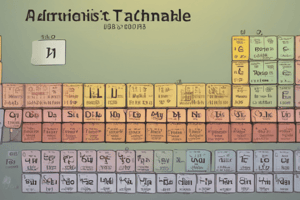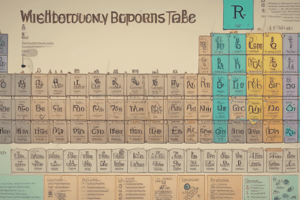Podcast
Questions and Answers
What is the definition of ductility?
What is the definition of ductility?
- Ability to be torn apart
- Ability to be melted
- Ability to be pulled into wire (correct)
- Ability to absorb moisture
What does malleability refer to?
What does malleability refer to?
- Ability to resist deformation
- Ability to be hammered into thin sheets (correct)
- Ability to reflect light
- Ability to be dissolved in water
What are the two types of conductivity?
What are the two types of conductivity?
- Thermal and magnetic
- Acoustic and visual
- Thermal and electrical (correct)
- Physical and chemical
What is density?
What is density?
What is luster?
What is luster?
Where are metals located on the periodic table?
Where are metals located on the periodic table?
What are common properties of metals?
What are common properties of metals?
Where are non-metals on the periodic table?
Where are non-metals on the periodic table?
What are common properties of non-metals?
What are common properties of non-metals?
Where are metalloids located on the periodic table?
Where are metalloids located on the periodic table?
What are common properties of metalloids?
What are common properties of metalloids?
The formula to calculate density is ____.
The formula to calculate density is ____.
If an object is 10 g and 5 mL, what is its density?
If an object is 10 g and 5 mL, what is its density?
If an object is 10 g and 20 mL, what is its density?
If an object is 10 g and 20 mL, what is its density?
If a cube is 2 cm per side and 4 g, what is its density?
If a cube is 2 cm per side and 4 g, what is its density?
What is mineral streak?
What is mineral streak?
What is the hardness of a mineral based on Moh's scale?
What is the hardness of a mineral based on Moh's scale?
What is mass?
What is mass?
What is volume?
What is volume?
What is water displacement?
What is water displacement?
Flashcards are hidden until you start studying
Study Notes
Physical Properties of Metals, Non-metals, and Metalloids
- Ductility: Metals can be drawn into thin wires without breaking.
- Malleability: metals can be hammered or rolled into thin sheets, exemplified by aluminum foil.
- Conductivity: This includes thermal conductivity (heat transfer) and electrical conductivity (electricity transfer).
- Density: Represents the compactness of particles in an object, with examples like a ping pong ball being less dense than a golf ball.
- Luster: Metals exhibit a shiny or metallic appearance, while non-metals typically have a dull appearance.
Metals, Non-metals, and Metalloids in the Periodic Table
- Metals: Located predominantly on the left side of the periodic table; most elements are classified as metals.
- Properties of Metals: Characterized by brightness (metallic luster), malleability, ductility, high density, high melting points, and good heat and electricity conductors.
- Non-metals: Positioned on the far right of the periodic table, beyond the stair-step line that segregates metals from non-metals.
- Properties of Non-metals: Tend to appear dull, lack malleability and ductility, have lower densities and melting points, and are poor conductors of heat and electricity.
- Metalloids: Found along the diagonal line on the right half of the periodic table, displaying mixed properties of both metals and non-metals.
Physical Measurements and Calculations
- Density Formula: Calculated as density = mass / volume.
- Density Example (10 g, 5 mL): Results in density of 2 g/mL; object will sink in water (density 1 g/mL).
- Density Example (10 g, 20 mL): Yields density of 0.5 g/mL; object will float in water.
- Cube Density Calculation: A cube with 2 cm sides and 4 g results in density of 0.5 g/cm³; it will float in water.
Minerals and Their Properties
- Mineral Streak: The color of the powdered residue left when a mineral is rubbed against a streak plate, aiding in mineral identification. For instance, gold produces a golden streak, pyrite yields a black streak.
- Hardness of a Mineral: Measured using Moh's hardness scale, from 1 (softest) to 10 (hardest); a mineral can scratch another with a lower number. Testing hardness can involve using a fingernail, a penny, or a metal nail.
- Mass: The amount of matter present in an object, typically measured in grams (g) or kilograms (kg).
- Volume: Refers to the space occupied by an object, measured in mL or cubic centimeters (cm³). Volume of a cube is calculated as length × width × height.
- Water Displacement Method: Used to determine the volume of irregular objects; involves measuring the rise in water level in a graduated cylinder when the object is submerged.
Studying That Suits You
Use AI to generate personalized quizzes and flashcards to suit your learning preferences.




